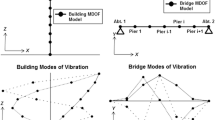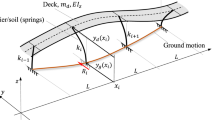Abstract
The performance of a typical four span continuous reinforced concrete bridge subjected to uniform and multiple seismic excitations at the supports is investigated in both the time and frequency domains. In the time domain analysis, a linear modal superposition approach is used to compute the peak response values. In the frequency domain analysis, a stochastically based linear random vibration theory is used to determine the root mean square response values where the cross correlation effects from the modal and the support excitations on the seismic response of the bridge model are included. The spatial variability of seismic ground motion may have a significant effect on the dynamic response of bridges. This study shows that the frequency domain analysis is preferred for the design purpose because of the computational advantage and the generality of the results. A practical range of peak factors that may be used with the stochastic analysis for computing the peak responses for typical continuous reinforced concrete bridges is provided.
Similar content being viewed by others
References
Abdel-Ghaffaar, A.M. and Rubin, L.I. (1982). “Suspension Bridge Response to Multiple Support Excitations.”Journal of Engineering Mechanics, ASCE, Vol. 108, No. EM2, 419–435.
Abdel-Ghaffaar, A.M. and Rubin, L.I. (1984). “Torsional Earthquake Response of Suspension Bridges.”Journal of Engineering Mechanics, ASCE, Vol. 110, No. 10, 1467–1484.
Applied Technology Council (ATC) (1997). “Seismic Design Criteria for Bridges and other Highway Structures: Current and Future.”ATC-18, Redwood City. Calif.
Clough, R. W. and Penzien, J. (1993).Dynamics of Structures, 2nd Ed., McGraw-Hill, New York, N.Y.
Der Kiureghian, A. and Neuenhofer, A. (1992). “Response Spectrum Method for Multi-Support Seismic Excitations.”Earthquake Engrg. and Struc. Dynamics, Vol. 21, No. 8, 713–740.
Floren, A. and J. Mohammadi (2001). “Performance-Based Design Approach in Seismic Analysis of Bridges.”Journal of Bridge Engineering, ASCE, Vol. 6, No. 1, 37–45.
Harichandran, R.S. and Wang, W. (1990). “Response of Indeterminate Two-Span Beam to Spatially Varying Seismic Excitation.”Earthquake Engrg. and Struc. Dynamics, Vol. 19, No. 2, 173–187.
Heredia-Zavoni, E. and Vanmarcke, E. (1994). “Seismic Random-Vibration Analysis of Multisupport Structural Systems,”Journal of Engineering Mechanics, ASCE, Vol. 120, No. 5, 1107–1128.
Leger, P., Ide, I.M. and Paultre, P. (1990). “Multiple Support Seismic Analysis of Large Structure,”Computers and Structures, Vol. 36, No. 6, 1153–1158.
Perotti, F. (1990). “Structural Response to Non Stationary Multiple Support Random Excitations.”Earthquake Engrg. and Struc. Dynamics, Vol. 19, No. 4, 513–527.
Saiidi, M. S., Maragakis, E. M., Isakovic, T. and Randall, M. (1997). “Performance-based Design of Seismic Restrainers for Simply-Supported Bridges” inSeismic Design Methodologies for the Next Generation of Codes, P. Fajfar and H. Krawindler, eds., Balkema, Rotterdam, The Netherlands.
Tan, D. (1994). “Discrete Analysis Method for Random Vibration of Structures Subjected to Temporarily and Spatially Correlated Excitations.”Computers and Structures, Vol. 50, No. 5, 619–627.
U.S. Department of Transportation (U.S. DOT) (1993). “Seismic Design of Highway Bridges.”FHWA HI-93-040, Federal Highway Administration, Washington, D.C.
Yamamura, N. and Tanaka, H. (1990). “Response Analysis of Flexible MDF Systems for Multi-Support Seismic Excitations.”Earthquake Engrg. and Struc. Dynamics, Vol. 19, No. 3, 345–357.
Zerva, A. (1990). “Response of Multi-Span Beams to Spatially Incoherent Seismic Ground Motions.”Earthquake Engrg. and Struc. Dynamics, Vol. 19, No. 6, 819–832.
Author information
Authors and Affiliations
Corresponding author
Additional information
The manuscript for this paper was submitted for review on February 15, 2001.
Rights and permissions
About this article
Cite this article
Yoon, C., Nazmy, A. Response factors for bridges subjected to uniform and multiple support excitations. KSCE J Civ Eng 5, 131–139 (2001). https://doi.org/10.1007/BF02829069
Issue Date:
DOI: https://doi.org/10.1007/BF02829069




